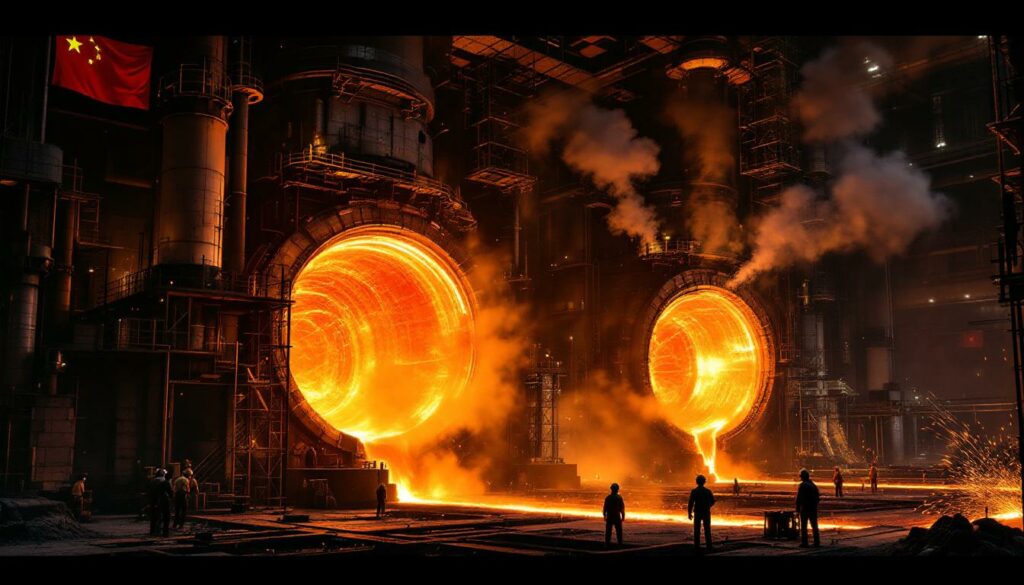Understanding the Recent Decline in Pig Iron Production in China
The pig iron production landscape in China is experiencing a notable shift, with recent data showing a downturn in output metrics across major steel-producing regions. According to the latest industry survey conducted by Shanghai Metal Market (SMM), several factors are contributing to this trend, with blast furnaces under maintenance playing a central role in the production decline. This development comes amid changing iron ore trends that are reshaping the global commodities market.
Current Operating Rates and Production Metrics
Recent figures from SMM's comprehensive survey of 242 steel mills across China reveal a clear downward trajectory in key production indicators:
- Blast furnace operating rate: 87.54% (down 0.42 percentage points month-on-month)
- Capacity utilization rate: 89.3% (down 0.15 percentage points month-on-month)
- Daily average pig iron production: 2.4137 million metric tons (down 4,200 metric tons month-on-month)
This decline, while modest in percentage terms, represents a significant volume impact given China's enormous production base. The operating rate measurement methodology employed by SMM factors in both the number of functioning furnaces and their relative capacity, providing a nuanced view of actual production capabilities.
Regional Distribution of Maintenance Activities
The geographic pattern of blast furnace maintenance activities shows a clear concentration in specific provinces:
- Primary maintenance regions: Hebei, Shanxi, and Fujian provinces are experiencing the highest levels of blast furnace downtime
- Production resumption areas: Liaoning province stands out as the main region where blast furnaces are returning to operation
- Critical focus area: Tangshan city in Hebei province is emerging as the epicenter of upcoming maintenance activities
Tangshan's outsized role in China's steel industry makes developments there particularly significant. The city alone accounts for approximately 8% of China's total steel output, according to 2024 National Bureau of Statistics data. When Tangshan's blast furnaces undergo maintenance, the ripple effects are felt throughout the national supply chain.
Factors Driving Increased Blast Furnace Maintenance
The current wave of blast furnace maintenance activities can be attributed to a combination of regulatory pressures, standard operational cycles, and strategic production decisions. Furthermore, these trends align with broader iron ore demand insights that indicate shifting market dynamics.
Regulatory Compliance Factors
Steel producers across China face increasingly stringent environmental regulations that directly impact maintenance schedules:
- Production control policies: China's 14th Five-Year Plan (2021-2025) includes specific steel production caps aimed at reducing carbon emissions
- Blue Sky Initiative: The Ministry of Ecology and Environment's flagship program requires steel mills to meet progressively stricter emission standards
- Regional enforcement variations: Local environmental protection bureaus implement national policies with varying degrees of stringency
According to industry sources, the environmental inspection teams dispatched to Tangshan are focusing on particulate emissions, sulfur dioxide levels, and energy efficiency metrics. Mills failing to meet standards face mandatory shutdown orders until remediation is completed. Many industry players are now exploring mining decarbonisation benefits to address these regulatory challenges.
"Environmental compliance is no longer optional for Chinese steelmakers. The days of running blast furnaces at maximum capacity regardless of emissions are over. Today's regulatory environment demands regular maintenance cycles and equipment upgrades to meet increasingly stringent standards." — Analysis from SMM Research, July 2025
Planned Maintenance Cycles
Beyond regulatory pressures, standard operational requirements drive predictable maintenance activities:
-
Typical maintenance durations:
- Minor maintenance: 7-14 days (refractory repairs, tuyere replacement)
- Medium maintenance: 15-30 days (cooling system overhaul, burden distribution system)
- Major relining: 45-60 days (complete refractory replacement)
-
Strategic timing considerations:
- Seasonal demand fluctuations (construction slowdowns during winter months)
- Raw material price cycles (taking advantage of lower iron ore prices)
- Production quota management (balancing annual output targets)
Industry standard practice typically calls for minor maintenance every 90-120 days of continuous operation, with major relining required every 10-15 years depending on furnace design and operating conditions. According to the blast furnace operations guide, these maintenance cycles are essential for optimal performance.
Current Maintenance-to-Production Ratio Analysis
The relationship between active maintenance and production resumption provides crucial insight into future output trajectories.
Maintenance vs. Resumption Statistics
Current data from the SMM survey reveals:
- 5 blast furnaces currently under maintenance across surveyed mills
- 1 blast furnace resumed operations during the reporting period
- Net reduction in operational capacity: 4 blast furnaces
This imbalance between new maintenance activities and resumptions represents a significant shift from the previous quarter, which saw a roughly 1:1 ratio between shutdowns and restarts.
The maintenance-to-production ratio (MPR) — calculated as the number of furnaces under maintenance divided by the total operational furnace count — currently stands at approximately 2.1%, slightly above the five-year average of 1.8% for this season, according to historical CISA data.
Future Maintenance Projections
Looking ahead, the maintenance outlook suggests continued pressure on production capacity:
- 2 additional blast furnaces scheduled for maintenance in the next reporting period
- 1 blast furnace expected to resume production
- Net projected reduction: 1 additional blast furnace
This projected net decrease will further reduce operational capacity, though at a slower rate than the current period. The maintenance schedule is heavily weighted toward medium-sized blast furnaces (1,000-2,000 cubic meters), which typically produce 3,000-5,000 metric tons of pig iron daily.
| Furnace Size Category | Current Maintenance | Planned Maintenance | Typical Daily Output |
|---|---|---|---|
| Small (<1,000 m³) | 1 | 0 | 1,000-2,500 mt |
| Medium (1,000-2,000 m³) | 3 | 2 | 3,000-5,000 mt |
| Large (>2,000 m³) | 1 | 0 | 5,000-10,000 mt |
Environmental Inspections and Their Production Impact
The intensification of environmental protection inspections represents a significant wild card in production forecasts. This aligns with broader trends related to China's iron ore decline as environmental policies continue to reshape the industry.
Tangshan Region Focus
Tangshan's strategic importance in China's steel industry makes it a natural focal point for environmental enforcement:
- The city houses over 100 steel mills ranging from small private operations to massive state-owned enterprises
- Local production accounts for approximately 140 million tons of annual crude steel capacity
- The region has historically been subject to some of China's most stringent environmental enforcement actions
Recent inspection activities have concentrated on emissions monitoring equipment validation, wastewater treatment facilities, and dust suppression systems. Mills found in violation face penalties ranging from temporary production restrictions to complete shutdown orders.
Production Forecast Implications
The ongoing and anticipated environmental inspections are likely to have measurable impacts on production metrics:
- Short-term outlook: Pig iron production may decrease by an additional 1-2% beyond current projections if inspection-triggered maintenance increases
- Regional production shifts: Mills in regions with less stringent environmental enforcement may increase production to compensate for Tangshan reductions
- Capacity utilization pressure: Mills attempting to maintain output targets with fewer operational furnaces may push remaining furnaces to higher utilization rates
According to SMM's proprietary production tracking model, which correlates historical inspection intensity with output reductions, the current inspection cycle could reduce Hebei province's pig iron output by 3-5% in the coming month if enforcement follows patterns observed in similar campaigns during 2024.
Market Implications of Reduced Pig Iron Output
The ongoing and projected declines in pig iron production have significant implications across the steel value chain.
Supply Chain Considerations
Reduced pig iron availability creates ripple effects throughout the steel production ecosystem:
- Immediate impact on steel output: Each ton of pig iron reduction typically translates to 1.05-1.15 tons of reduced crude steel capacity
- Inventory depletion: Mills with reduced pig iron output will draw down existing inventories, currently estimated at 9-11 days of production according to CISA
- Alternative input sourcing: Increased demand for steel scrap as mills adjust charge materials to compensate for reduced hot metal availability
Historical patterns suggest that mills will implement tiered response strategies based on the expected duration of pig iron constraints:
- Short-term constraints (<15 days): Inventory drawdown and minor production adjustments
- Medium-term constraints (15-45 days): Increased scrap utilization and product mix optimization
- Long-term constraints (>45 days): Significant production rate reductions and customer allocation systems
Price Impact Potential
Past correlations between maintenance cycles and market prices suggest potential pricing movements:
- Pig iron price elasticity: Historically, a 1% reduction in national pig iron output has corresponded to a 0.8-1.2% increase in pig iron spot prices
- Steel product price transmission: Price increases typically flow through to finished steel products with a 7-14 day lag
- Regional price differentials: Areas with concentrated maintenance activities (e.g., Hebei) tend to see larger price increases than regions with stable production
Based on SMM's price indices from similar maintenance cycles in 2024, the current production decline could support a 3-5% increase in pig iron prices over the next 30 days if other market factors remain stable. Analysts are closely monitoring these developments as part of broader iron ore forecast insights.
Historical Context for Current Maintenance Trends
To properly evaluate the significance of current blast furnace maintenance activities, historical context is essential.
Seasonal Maintenance Patterns
Blast furnace maintenance activities typically follow predictable seasonal patterns:
- Summer maintenance peak: Historically, July-August sees 15-20% higher maintenance activity than annual averages
- Winter enforcement windows: Environmental restriction-driven maintenance increases during heating season (November-March)
- Annual production rhythms: Maintenance often accelerates toward year-end as mills manage annual production quotas
The current maintenance level, while elevated from the previous month, remains within the expected seasonal range based on five-year averages compiled by SMM.
Production Control Effectiveness
China's production control policies have demonstrated varying degrees of effectiveness across regions:
- Compliance variations: Tier 1 cities (Beijing, Shanghai) and environmentally sensitive regions (Hebei) show 85-90% policy compliance rates
- Implementation lags: Second and third-tier steel-producing regions typically demonstrate 60-75% compliance rates
- Long-term impact: Despite periodic fluctuations, China's annual steel output growth has moderated from double-digit rates to low single-digit growth
The current maintenance cycle reflects the continued effectiveness of these policies, particularly in environmentally prioritized regions like Tangshan.
FAQ: Blast Furnace Maintenance and Pig Iron Production
What factors determine when a blast furnace undergoes maintenance?
Blast furnace maintenance timing is determined by multiple factors:
- Refractory wear: Internal lining degradation measured through thermal imaging and temperature monitoring
- Regulatory requirements: Scheduled inspections and environmental compliance windows
- Operational efficiency: Declining productivity metrics (e.g., reduced hot metal temperature, increased fuel rates)
- Strategic production planning: Aligning maintenance with market demand cycles
According to metallurgical engineering standards, most modern blast furnaces can operate continuously for 6-8 years between major relinings, though partial maintenance is required much more frequently.
How does blast furnace maintenance affect the broader steel market?
The impact of maintenance activities extends throughout the steel value chain:
- Immediate steel production constraints: Reduced hot metal availability limits basic oxygen furnace operations
- Product mix adjustments: Mills often prioritize high-margin products during reduced production periods
- Regional supply imbalances: Localized shortages may develop if maintenance is concentrated in specific regions
- Price volatility: Spot market prices for both pig iron and finished steel typically increase during major maintenance cycles
Market participants have developed various strategies to manage these impacts, including advance purchasing, inventory building, and contract flexibility provisions.
What is the typical duration of blast furnace maintenance?
Maintenance duration varies significantly based on the scope of work:
- Routine maintenance: 3-7 days (tuyere replacement, minor refractory repairs)
- Intermediate overhauls: 15-30 days (hearth maintenance, cooling system repairs)
- Major relining: 45-90 days (complete refractory replacement)
- Modern reconstruction: 100-120 days (technology upgrades, efficiency improvements)
Technological advances have reduced some maintenance durations over time. For example, modern quick-change tuyere systems have reduced routine maintenance windows by 30-40% compared to previous generations.
How do steel mills compensate for production losses during maintenance?
Mills employ various strategies to mitigate the impact of blast furnace downtime:
- Production acceleration: Increasing output from other operational furnaces by 3-5% where technically feasible
- Inventory management: Building finished product inventories prior to planned maintenance
- Alternative ironmaking: Increasing electric arc furnace production using scrap and DRI/HBI
- Customer communication: Providing advance notice to key customers to adjust delivery expectations
Larger integrated steel groups with multiple production sites often redistribute orders to facilities unaffected by maintenance activities.
Future Outlook for Pig Iron Production
Looking ahead, several key factors will influence China's pig iron production trajectory.
Short-Term Production Forecast
Based on current trends and announced maintenance schedules:
- July outlook: Continued slight decline in pig iron production, potentially reaching 87.0% operating rate
- Regional variations: Hebei province likely to see 3-5% production decreases while northeastern regions may increase output by 1-2%
- Environmental wildcards: Intensified inspections could accelerate maintenance activities beyond currently scheduled levels
The concentration of maintenance in Tangshan is particularly significant given the city's outsized contribution to national output. If additional furnaces in this region are idled, the impact on national production metrics would be disproportionately large.
Market Adaptation Strategies
Industry participants are developing various approaches to navigate the current maintenance cycle:
- Steel producers: Optimizing product mix toward higher-margin items during reduced output periods
- Steel buyers: Forward-purchasing critical specifications and building safety stock levels
- Traders: Increasing import positions for pig iron from Russia and Southeast Asia to fill domestic supply gaps
Experience from previous maintenance cycles suggests that market equilibrium typically returns within 30-45 days as producers complete scheduled work and resume normal operations.
Disclaimer: The production forecasts contained in this article represent current expectations based on announced maintenance schedules and historical patterns. Actual production levels may vary based on regulatory developments, market conditions, and individual company decisions. This information should not be used as the sole basis for business or investment decisions.
Additional Considerations for Market Participants
Regional Supply-Demand Balances
The geographically concentrated nature of current maintenance activities creates potential regional imbalances:
- North China: Potential supply tightness as Hebei maintenance reduces local availability
- East China: Relatively balanced conditions as maintenance is less concentrated
- South China: Potential oversupply if northern material is redirected to southern markets
These regional variations may create arbitrage opportunities for traders able to move material between surplus and deficit regions.
Environmental Policy Evolution
The increasing frequency and intensity of environmental inspections reflects China's evolving approach to industrial regulation:
- Carbon reduction goals: China's dual-carbon (peak carbon by 2030, carbon neutrality by 2060) strategy continues to drive policy
- Production concentration: Government policies favor larger, more efficient producers over smaller operations
- Technology priorities: Mills investing in ultra-low emission technologies face fewer production restrictions
Understanding this regulatory direction provides context for interpreting current maintenance trends and anticipating future developments.
Technological Innovation in Maintenance Processes
Advances in blast furnace maintenance technology are gradually reducing downtime requirements:
- Hot repairs: New techniques allow some maintenance activities without complete shutdown
- Modular designs: Prefabricated components reduce installation time during major repairs
- Predictive maintenance: AI-driven monitoring systems identify issues before failure occurs
These innovations are helping progressive mills reduce maintenance-related production losses by 15-25% compared to traditional approaches.
By understanding these broader market factors alongside the specific maintenance data, industry participants can better navigate the current production landscape and anticipate potential challenges and opportunities in China's pig iron market.
Ready to Stay Ahead of the Next Major Mineral Discovery?
Stay informed about significant ASX mineral discoveries with real-time alerts from Discovery Alert's proprietary Discovery IQ model, delivering actionable insights for both short-term traders and long-term investors. Explore historic returns of major mineral discoveries by visiting our discoveries page and begin your 30-day free trial today to gain a market-leading advantage.




